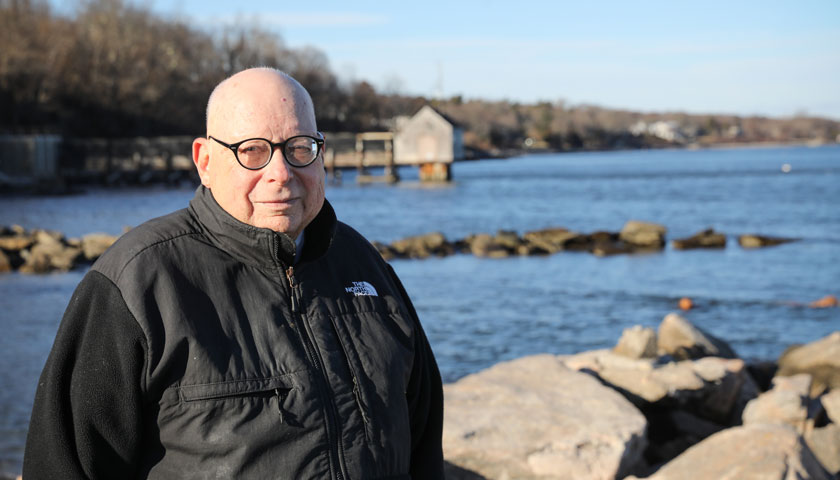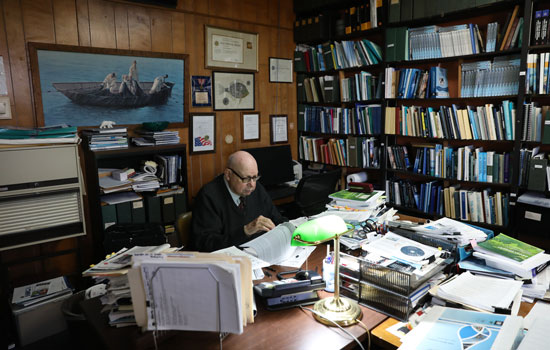Marine Sustainability: A Life's Work Continues

Winter is approaching, and 85-year-old Dr. Kenneth Sherman, BS’54, is preparing for an upcoming trip – not to a Florida beach resort or a leisurely golf weekend, but to Cape Town, South Africa, to check in on the Benguela Current Large Marine Ecosystem (BCLME).
Spanning more than 200,000 square kilometers off the coasts of Angola, Namibia, and South Africa, the BCLME is one of 66 such large marine ecosystems identified worldwide. The governments and key industrial leaders of all three countries work together in surprising harmony to improve the health of their shared marine environment – and that unlikely partnership, like other such efforts all around the world, owes its existence in no small part to Sherman.
A sea change
Sherman is the director of the Large Marine Ecosystem Program at the National Oceanic and Atmospheric Administration’s Northeast Fisheries Science Center in Narragansett, R.I. It was here, more than 30 years ago, that he first set in motion a sea change in how scientists assess and care for the world’s coastal waters.
“One of the colleagues I met here,” says Sherman, “who happened to be my neighbor – and a stickler for landscaping perfection, by the way, he told me how to rake my leaves and cut my grass and so on – one day I said to him, ‘I have an idea, and I’d like to try it out on you over Polish vodka. Let’s go sit down.’”
The neighbor was Lewis Alexander, a professor of marine affairs at the University of Rhode Island. And the idea – the concept of large marine ecosystems – would eventually win Sherman the Göteborg Award in 2010, considered the sustainable development equivalent of a Nobel Prize.
“I suggested to him,” Sherman says, “that it’d be possible to identify, using four criteria, bits of the coastlines around the world and establish them with boundaries on the basis of ecological criteria, not political criteria.”
Sherman and Alexander presented that concept of large marine ecosystems – connected yet distinct oceanic ecosystems characterized by their undersea topography, hydrography, productivity, and food chain dynamics – at an international conference before thousands of scientists. “We hit a very responsive nerve, so to speak,” he says.
Oceans under threat
“We have serious issues in the oceans, they’re under extreme stress,” Sherman says. And most of that stress – whether from overfishing, warming waters, shipping, pollution, or offshore drilling and mining – is the result of expanding global human populations, who risk exhausting the resources of their coastal waters.
“Once we focused attention on the issue, we found a huge amount of interest, pent up energy,” Sherman says. “We came up with the idea at the right time, presented it in the right venue, and since that time it’s grown on the basis of what people could envision both at the scientific level and at the political level.”
Global cooperation
Viewed through the complexities of world events, the global political collaboration that large marine ecosystems (LMEs) have inspired is perhaps what’s most remarkable. The UN’s Conference on Environment and Development held in Rio in 1992 marked a turning point. “The heads of state who went to these meetings,” Sherman says, “they put it on the front burner and they raised not millions but billions – the first time in history that such a large amount of funding was earmarked to improve the world’s environment.” The Global Environment Facility located within the World Bank has since catalyzed more than $3 billion, helping to sustain marine ecosystems in 110 countries, using Sherman’s framework.
Defining the ecosystems based solely on scientific criteria, without regard to political borders, has helped foster a spirit of cooperation. “It’s difficult to imagine, but we’ve had no significant issues about where those boundaries ought to be or anyone fighting over them since 1983,” Sherman says.
He also credits the people and organizations managing the funds and the work in each location. “Fortunately a lot of people are involved, so I don’t have to travel as much as I have in the past,” he says. “And there’s a big enough footprint now around the world that this should carry on even when I’m an angel.”
Suffolk helped turn a boyhood fascination into a career
Sherman had always been intrigued by the ocean and the life within it – ever since his father would take him down to Boston’s T Wharf as a child. “The smell of the fishing boats tied up with disgusting gurry hanging from the nets was a source of great interest to a five year old, so I was always wondering what was behind those boats,” he says.
At Suffolk in the early 1950s, Sherman worked days – at one point slogging boxes of women’s apparel through the slush and snow – and attended class at night, intending to go to law school. “I was a pre-law student who had this longstanding interest in the oceans and living things and biology,” Sherman says. That is, until a professor inspired him to bypass law for ocean science.
“His name was Robert Friedman. He changed me, he’s the reason I’m here,” he says.
“[Friedman] committed himself to working-class kids, to show us things we had never seen nor heard about – that there were things we could do that we didn’t know we could do. So I took every course in biology that he had to offer, and in one case I was his only student.”
That commitment to working-class students is something Sherman still associates with Suffolk. “Suffolk reached down to the working class and said if you’re willing to work hard, you can earn a degree,” he says. “You can actually work while you’re going to school. That’s an opportunity.”
More importantly, he adds, when working-class people are able to bring their life experiences and grit with them into the classroom, it can help their peers – and the world. “We can bring more to the table … in terms of desire, commitment, persistence to get on with reaching an objective. It’s not easy. Those things are learned in the working-class background, and those are just the kind of people who can make the world a better place.”
From Boston to the world
After graduating, Sherman’s early career took him far beyond the streets of Boston: to Hawaii, which he found boring after a year or two, to 1970s Poland, where he convinced the communist leadership to let its workers help identify plankton samples (they’re still at it 43 years later), and into the work and offices of some of America’s most prominent early marine biologists – such as Henry Bigelow, who founded the Woods Hole Oceanographic Institution.
“I’m a part of that history, albeit a small part,” Sherman says. “So that’s what makes science exciting for anyone to consider: the kinds of shoulders you’re sitting on top of. It’s always being built on and extended.”
And there’s still a lot to build on, Sherman says. “We haven’t solved all the problems yet,” he says, which should motivate today’s students. As the climate warms and the swelling human population puts more stress on the natural environment the rate of solutions will have to be commensurate to sustain the planet.
That’s one reason Sherman continues to work and travel the world, well into his 80s. “We’re not like cats, we don’t have nine lives. So you’ve got to do the best you can with the one you’ve got.”

Media Contact
Greg Gatlin
Office of Public Affairs
617-573-8428
[email protected]



